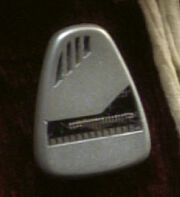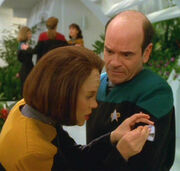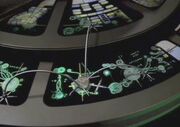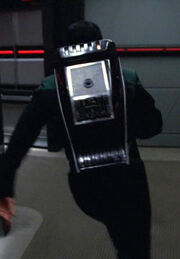m (Reverted edits by 115.248.37.26 (talk | block) to last version by Renegade54) |
|||
| Line 37: | Line 37: | ||
=== External link === |
=== External link === |
||
| + | * {{NCwiki}} |
||
| − | * [http://mobile-specifications.com/ Mobile Emitter] |
||
[[cs:Mobilní emitor]] |
[[cs:Mobilní emitor]] |
||
[[de:Mobiler Emitter]] |
[[de:Mobiler Emitter]] |
||
| − | [[Category:Holographic technology]] |
||
| − | [[Category:Holographic technology]] |
||
| − | [[Category:Holographic technology]] |
||
[[Category:Holographic technology]] |
[[Category:Holographic technology]] |
||
Revision as of 13:20, 30 April 2013
AT: "xx"

The mobile emitter
The autonomous self-sustaining mobile holo-emitter, or mobile emitter, was a piece of 29th century technology designed to remotely power and enable a single holographic instance away from permanent holoemitters. Constructed of a poly-deutonic alloy unknown to 24th century science, the mobile emitter was approximately the size of a Human palm. (VOY: "Future's End, Part II", "Message in a Bottle", "Drone", "Renaissance Man")
Origins
The Doctor in 1996 Los Angeles
Owned by Henry Starling in 1996, the emitter was either aboard the appropriated Aeon timeship, or derived from the 29th-century technology therein. Starling used the emitter to grant mobility to his captive, The Doctor, while the latter was displaced in time after he hacked into Voyager's computers and stole the hologram, concluding that trapping the Doctor in the emitter would make him a better hostage as the emitter made a smaller, easier target. After being returned to the 24th century by Captain Braxton, the USS Voyager was allowed to retain the anachronistic mobile emitter, granting The Doctor a new-found mobility and utility beyond Voyager's sickbay and holodecks, able to slip the emitter on and off relatively easily. (VOY: "Future's End, Part II")
Usage
The mobile emitter was a wholly self-contained holographic projector, generating the photons and force fields necessary to allow a hologram to physically interact with its environment. The emitter was either affixed to the exterior of the active holoprogram and thereby visible, or it could be covered or enveloped by the program, effectively hiding it from view. (VOY: "Renaissance Man")
The exact power source of the emitter was never revealed, but it would appear to be capable of operating in most conditions without charging; during the Year of Hell, the Doctor was forced to rely on the emitter for the better part of a year after Sickbay was destroyed in the first wave of the Krenim attack, showing no sign that this was any kind of serious handicap to him or that the emitter's continued power supply might run down even as Voyager itself was left in increasingly battered condition by the Krenim attacks (VOY: "Year of Hell", "Year of Hell, Part II"). However, the emitter could be disrupted by certain conditions; when Voyager spent a month passing through a nebula, prolonged exposure to the nebula's environment affected the emitter's ability to operate, and the Doctor's attempt to circumvent this issue by tying the emitter into the EPS manifold was only a temporary solution (VOY: "One").
Compatibility

Torres modifies the mobile emitter while in use
Eminently compatible with 24th century Federation technology, stored holographic programs (active and inactive) could be transferred to and from the emitter with ease, as simply as a voice command. (VOY: "Renaissance Man") Although B'Elanna had some trouble understanding how the emitter worked, she was once able to reconfigure the Doctor's perceptions via the emitter in order to better scan their environment when Voyager was stolen by the Nyrians and the crew trapped in their artificial biosphere (VOY: "Displaced").
The mobile emitter's internal power source could also interact with a variety of other technologies to function as an impromptu battery. The Doctor's emitter was kept offline in 2375 while stranded inside a subspace sinkhole in the event it would be needed for emergency power. (VOY: "Gravity")
Fifteen years later, after the emitter was rescued from the derelict Voyager in an alternate 2390, Harry Kim used it to power a stolen Borg temporal transmitter, contacting Seven of Nine and preventing Voyager's crash, erasing this timeline. (VOY: "Timeless")
Several Federation-designed holoprograms interfaced with The Doctor's mobile emitter without difficulty, including the EMH from the USS Equinox, a holoprogram of Leonardo da Vinci, Reginald Barclay's hologram of himself, and Hirogen hologram Iden. (VOY: "Equinox", "Equinox, Part II", "Concerning Flight", "Inside Man", "Flesh and Blood")
Untoward functionality

The mobile emitter assimilates a science console.
In 2375, a transporter accident resulted in The Doctor's mobile emitter being contaminated with nanoprobes. The probes assimilated the emitter, and after sampling Ensign Mulcahey's DNA, it built a maturation chamber and ultimately became embedded in the cerebral cortex of a highly-advanced Borg drone, designated One. After One's death, the mobile emitter was retrieved and returned to The Doctor for his use. (VOY: "Drone")
In fiction

The fictional mobile emitter in Photons Be Free
The Doctor's holonovel Photons Be Free had a fifty kilogram backpack version of the mobile emitter – intended to reflect the burden of responsibilities that he faced – that the protagonist had to wear to leave sickbay on the USS Vortex. This version of the mobile emitter was one of the prominent features of "Chapter 5 - "Out of the Frying Pan" (in which our protagonist must confront abusive colleagues)".
Appendices
Apocrypha
Another version of the mobile emitter was in the novel Homecoming. In the book, Henry Bates, a holographic-rights sympathizer, creates a functionally equivalent emitter about the size of a briefcase.
In the timeline of Star Trek Online, The Doctor filed a lawsuit against Starfleet to retain control of his mobile emitter, leading to a movement lobbying to establish civil rights for sentient artificial lifeforms, including holographic (photonic) projections and androids. The Soong Foundation develops a mobile emitter for civilian use, and photonic lifeforms equipped with mobile emitters serve on away teams alongside biological beings.
External link
- Template:NCwiki
